Facebook Dropping Election Ads to Limit Trump Victory Claims: Eisenstat
Categories
Categories
Categories

Have you ever listened to a playlist that’s supposedly been ‘Made For You,’ but has only left you wondering if the platform ‘knows’ you at all?
Algorithmic streaming recommendations can be quite useful when seeking artists similar to those you already listen to, but using those generated playlists to discover a wide range of new content can be difficult. What if you wanted to listen to what your friends were listening to, but they all have different music tastes from your own? If you can’t remember their favorite band or song’s name, you’ll be out of luck.
Four Cornell Tech students jumped at the chance to innovate when they noticed this lack of diversity and social connection. Wishing that there was an easy in-app way to share what they were listening to with friends, the team came together to design a potential new feature: Spotify Groups.
How it began
Chan Baik and Shuhan Zhang, both Johnson Cornell Tech MBAs ‘20, Bobo Liu and Jae Min Cha, Masters of Engineering in Computer Science ‘20, and Max Klein and Rebecca Gill-Clarke, students from the Parsons School of Design, were matched up with Spotify during their BigCo Studio course where students learn how to innovate within a large company. “It was exciting to get Spotify since we already use it and had many different ideas,” said Zhang.
To start, the team gathered input from a diverse group of regular Spotify users on any problems or limitations they encountered while using the platform. “There is already a huge built-in user base getting on to listen to music. There wasn’t a need for extensive research to capture a niche market,” said Liu.
After speaking to various users, the team realized they had to stay focused on one stand-out idea, which was to help users find more diverse content through their friends. “Our interviews with users showed that they didn’t always necessarily want Spotify’s recommendations on what to listen to. They said they’d like to have an additional collaborative feature to share music among friends,” said Zhang.
Together with Spotify stakeholders, the team assessed various solutions alongside Spotify’s business objectives: the number of monthly active users, strategic importance, and new user growth potential, as well as the idea’s long-term technical scalability and feasibility. After brainstorming some ideas, the team decided on integrating a ‘Groups’ feature into the Spotify interface.
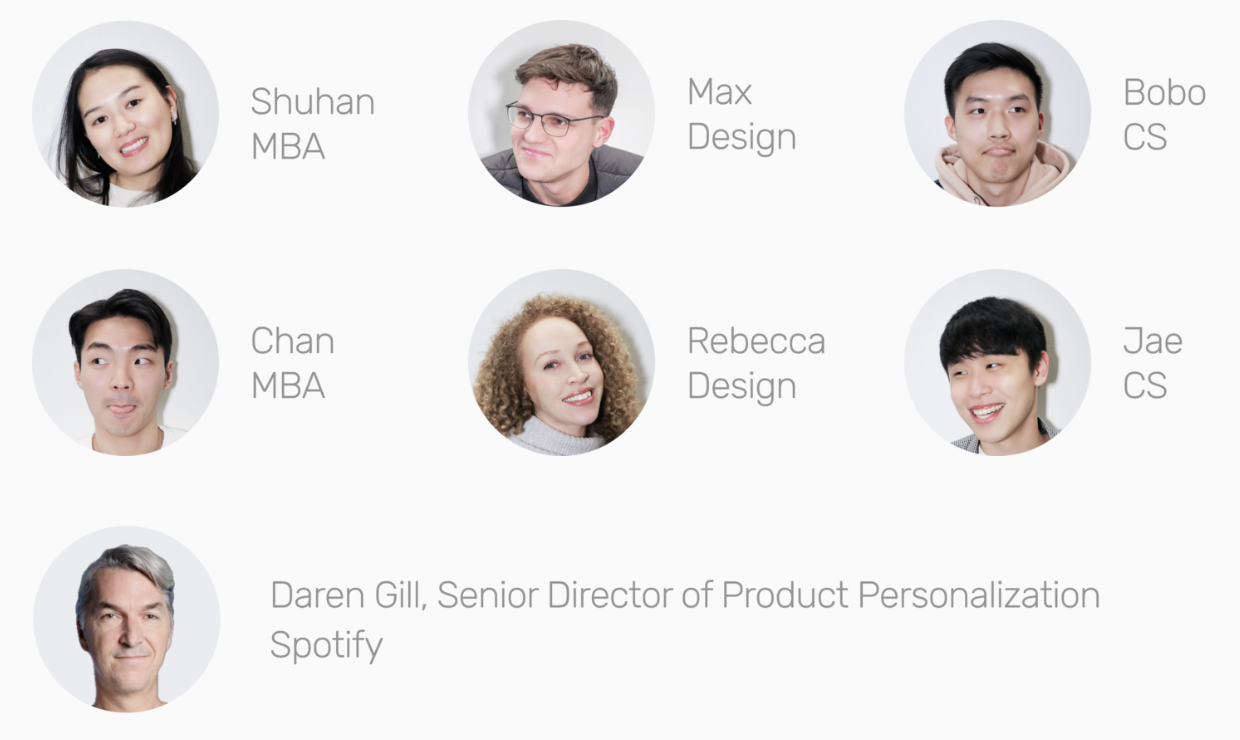
An interactive environment
The idea of Spotify Groups is to offer users a social and collaborative environment, similar to those on other popular social media platforms, to drive music and podcast discovery based on the tastes of their friends and family. A user can aggregate a curated slate of content for others or open it up for collaboration, somewhat akin to the way playlists are created on the platform. Users can also know what their friends are listening to, and more easily share their favorites as well.
With this idea in mind, the team worked with advisors from Spotify to chart out the potential places to display Spotify Groups in-app. Klein and Gill-Clarke helped visually design the team’s ideas, all while integrating them within Spotify’s brand, design specs, and internal framework. “We were lucky with our designers Max and Rebecca — they were very detail-oriented, even down to the pixels,” said Baik.
If implemented, the feature will be situated next to other toggle options on Spotify, such as ‘Music,’ and ‘Podcasts.’ Clicking on ‘Groups’ will populate the feature offerings in a way that becomes more individualized the more a user curates and creates preferences and friend circles.
It will also introduce interactivity for users, both between other users and with the content offered on the platform.
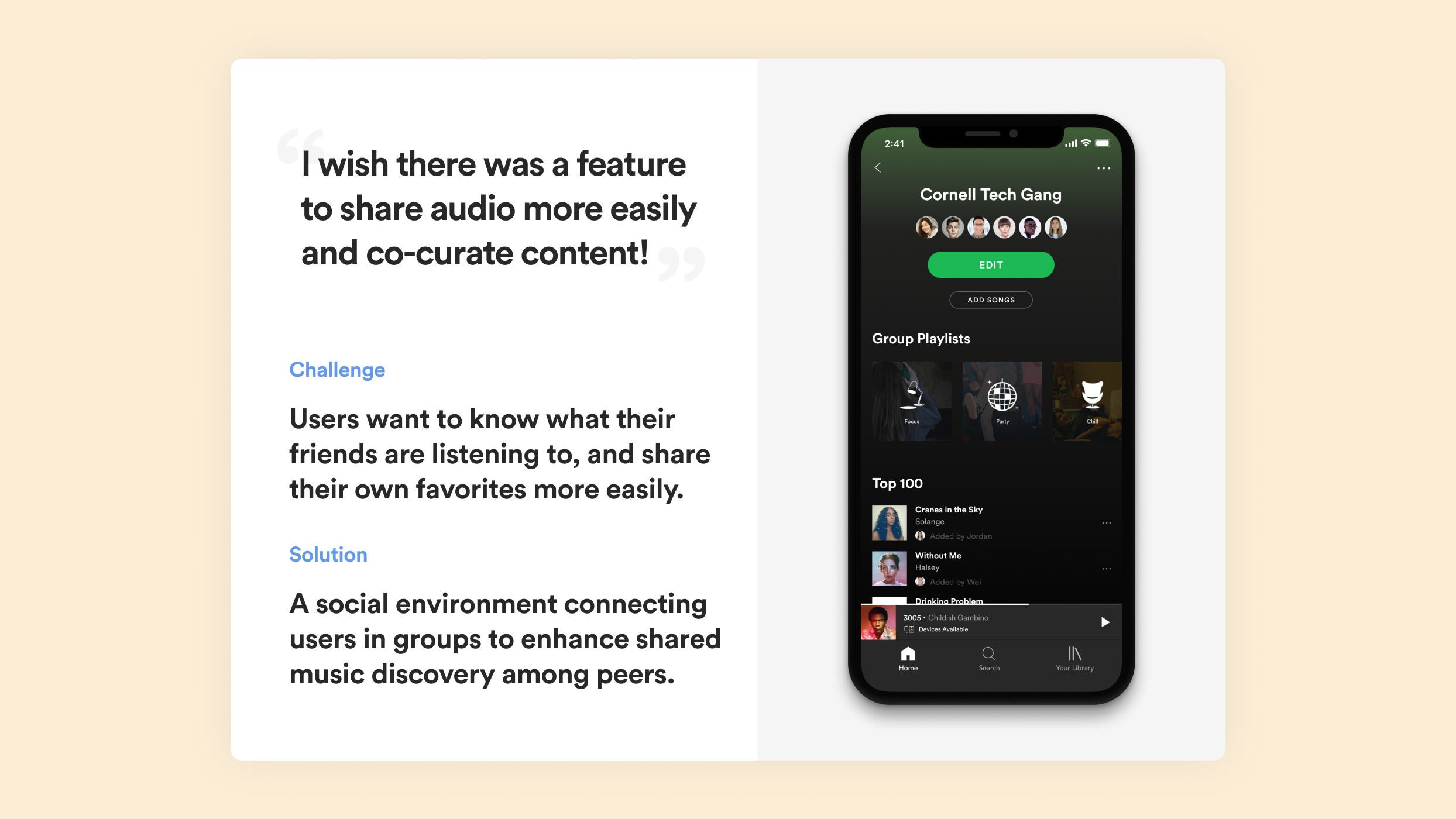
Going forward, what’s next?
“BigCo Studio gave us good tips on how to efficiently interact with very busy company advisors. That, as well as our team members, is what made us succeed with the project. And the good news is that the nature of BigCo projects is that no one owns the idea, it is public,” said Zhang. Since the project is open-source, a dedicated person or team at Spotify can work on building the project uninhibited by high costs or holdouts based on ownership.
A workable version of Spotify Groups could be in the hands of users soon. “There were talks about offering this as an intern project, but we have to wait and see. Hopefully, they make it in the near future. We’d all use it ourselves,” said Liu.
Categories

Emilie Burton, Jacobs Technion-Cornell Dual Master of Science Degrees with a Concentration in Health Tech ‘21, was born in France and grew up in England. She received her BS in Bioinformatics with a minor in Biostatistics from Loyola University Chicago. Prior to Cornell Tech, she worked as a next generation sequencing data scientist in Silicon Valley for three years.
What is your favorite class so far?
My favorite class has been Technology and Social Justice, taught by Nicola Dell. This course examines the design, deployment, and adoption of technologies that engage with social justice issues. It expanded my horizon on how to evaluate technology and gave me new ways of thinking about how technologies engage with communities and how the design approach can serve communities.
What excites you most about your program?
The Health Tech concentration is unique in that it combines technical, health, and business courses. I love how interdisciplinary the curriculum is and how it strives to anchor our technical skills with a deeper understanding of healthcare delivery, digital health, decision support, and global medicine. We can take classes at Weill Cornell Medicine, shadow doctors, and have experts in the healthcare domain advise us on our projects. I’m also excited about participating in iTrek — a 10-day academic and cultural trip that offers students an opportunity to learn about the economy of innovation in Israel — this year and collaborating with Tel Aviv University students to create digital health solutions.
Why did you choose Cornell Tech?
Aside from the fantastic interdisciplinary curriculum, I chose Cornell Tech for its Startup Studio program. This novel class brings students from every discipline (engineers, computer scientists, law, business) to develop, test, and build a new startup idea. It is an opportunity to learn the entrepreneurial mindset and work with people from diverse backgrounds and different skills.
What’s the most interesting use of technology you’ve seen lately?
Deborah Estrin’s work on small data — the examination of digital breadcrumbs and how they can be leveraged for personalized healthcare management.
What is one of your favorite things to do on the weekend in NYC?
I love exploring new neighborhoods and going to The Met (hands down favorite museum ever).
In what way do you hope your work might affect others and society at large?
I aspire to help people/communities understand data better to make more informed decisions.
How do you describe Health Tech to your friends and family?
Health Tech is the intersection of healthcare, technology, and business. The program teaches us how to design new technologies tailored to the context of healthcare.
Categories
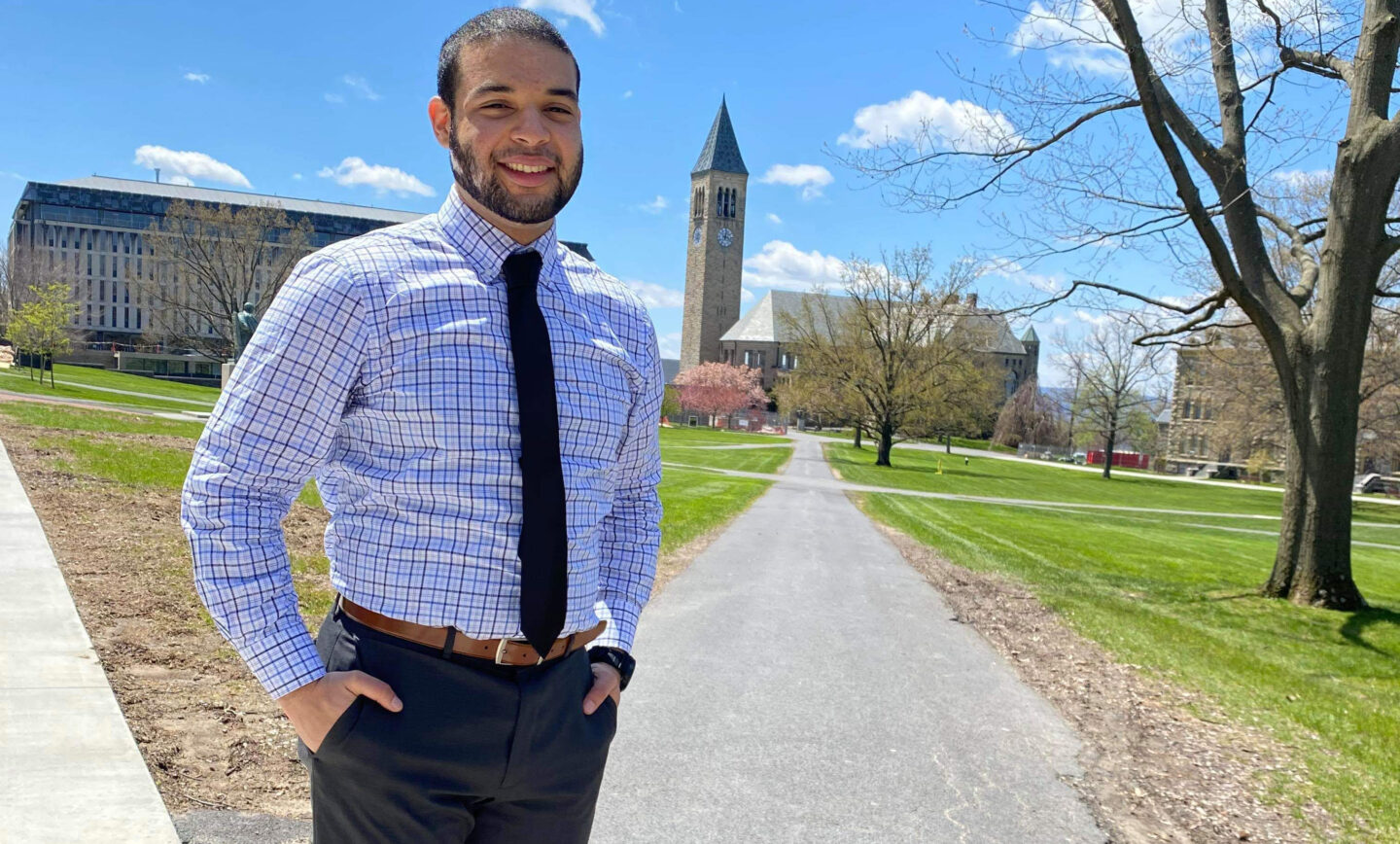
Isaiah Murray, Jacobs Technion-Cornell Dual Master of Science Degrees with a Concentration in Urban Tech ’22, is currently studying from his hometown, San Antonio, Texas. He previously studied at Cornell University in Ithaca, New York where he graduated with a B.A. in Information Science, a B.S. in Urban & Regional Studies, and a minor in Inequality Studies in the Spring of 2020.
What is your favorite class this semester?
All the classes I am currently taking are super interesting, but if I had to choose one class that piques my interest a little more than the rest, I’d have to choose Revolutionary Technologies taught by Professor Parikh. This class has raised my critical consciousness of the technologies we have created and are to create. Taking this course in conjunction with Product Studio is a mix that has sparked many dialogues about capitalism and the values it encourages among its participants and how those are or are not in line with our humanity.
What excites you most about your program?
Regardless of what class it is, I am always excited to attend. With the backdrop of the pandemic, the inequality I see in my hometown, not to mention the country, attending class is a way I gain perspective of my surroundings and brainstorm potential solutions. Knowing that I can in fact access the world of Cornell Tech from afar, is exciting in and of itself.
Why did you choose Cornell Tech?
Cornell Tech was one of the very few schools I applied to that had a program devoted to the study of urban science, technology, and entrepreneurship. This triangle of study struck me as a unique combination inspiring people-centered innovation. With cities becoming more populous as we progress into the future, I want to prepare myself to be someone who ensures that all residents have access to what the city can offer.
What has surprised you most about Cornell Tech?
Online school is the current reality of many students across the globe and I am happy to say that Cornell Tech has transitioned online seamlessly. Never had I done online school for all my classes and I can say that this experience was not nearly as bad as I thought it was going to be. Although there is nothing that can replace in-person interaction, I commend Cornell Tech for creating an online experience that continues to keep me involved.
What’s the most interesting use of technology you’ve seen lately?
Just a few weeks ago, I witnessed a 4th grade class on Zoom. My little cousin participated in collaborative activities, group reading, and class assignments all online. I would have had no insight as to how to run a 4th grade class on Zoom and became intrigued at how my little cousin would interact with her class.
What is one of your favorite things to do on the weekend in NYC?
I am not currently in New York City, but I did however spend last summer in NYC working at a non-profit. Among the many things I did during the weekend, I found that the night I spent on the rooftop playing cards, drinking wine, and listening to music with friends is my most fond memory. Now with social distancing measures, I am happy to say my version of fun has not been impacted so much.
In what way do you hope your work might affect others and society at large?
I hope that my study of urban technology takes me on an academic journey where I identify the essence of what it means to be human and amplify that with technology. Our world is rampant with racism, colorism, ableism, xenophobia, mental health issues, climate change, etc. — not to mention COVID-19. Using cities as a catalyst, I hope to empower people to create status quos that promote equity and equality.
How do you describe Urban Tech to your friends and family?
When people ask what I study, I tell them I am learning how to make cities better places for people with technology. As vague as that may sound, I believe this description is easy to understand, hopefully inspiring them to consider how they can affect positive change through this avenue as well.
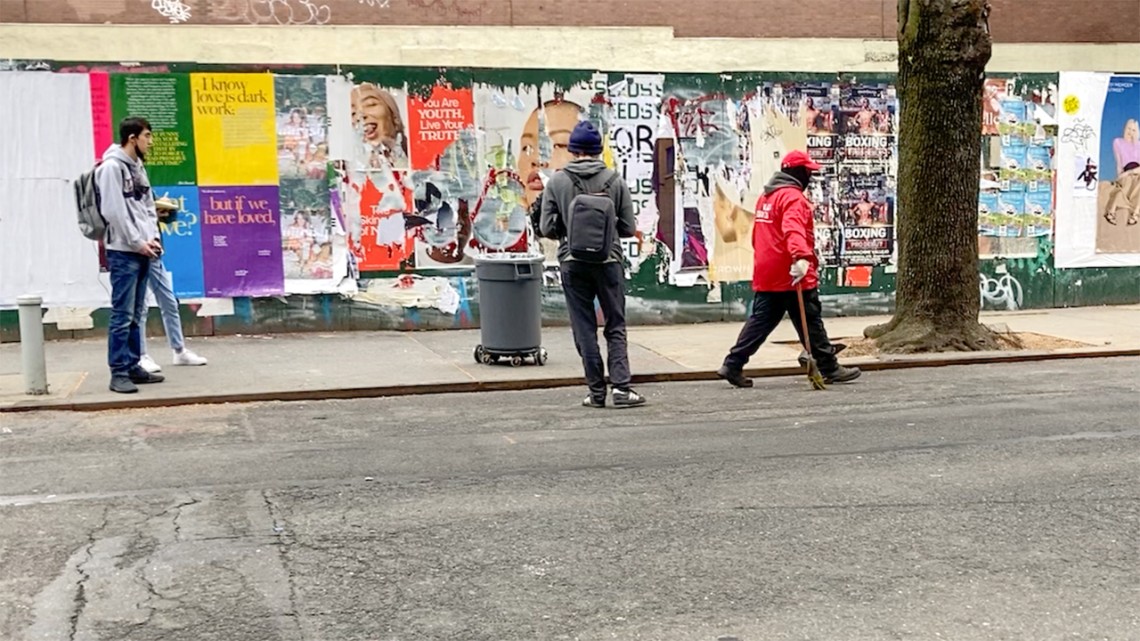

A stroll through the American Museum of Natural History was the catalyst, but OnePlace co-founder Daniel Asper, Johnson Cornell Tech MBA ‘20, had been imagining what a digital information hub for families could look like for some time. Lessons from The Hall of African Peoples sparked more thinking around the importance of family in society and how a central place for your tribe’s tools and information has always been important through the generations. This seemed like something that needed to exist for modern family life, and so the journey to build OnePlace began.
From the museum to the marketplace
OnePlace aims to help families prepare for life events with the tools and guidance they need to keep track of their most important documents in “one place.” Chief Product Officer Sunny Ladkani, Johnson Cornell Tech MBA ‘20, said that along with safe and secure document storage, the platform will initially focus on the gathering of life’s most important documents — they expect to see private essentials like passports, wills, insurance, healthcare, identification cards, and more in digital form. The interface will be instructive and visual to help users know what they need.
The OnePlace vision takes a long-term approach — looking at where society is going to be rather than where it is now. The team envisions OnePlace as the technological dwelling of information not just years down the line, but entire generations and more. The goal is to aid with familial collaboration in organizing and storing the paramount data for the entire family, with eyes fixed toward what will be helpful to have on hand for the future.
The inventiveness and work that followed resulted in the newly graduated foursome receiving co-working space on the Cornell Tech campus for the team to pursue their startup.
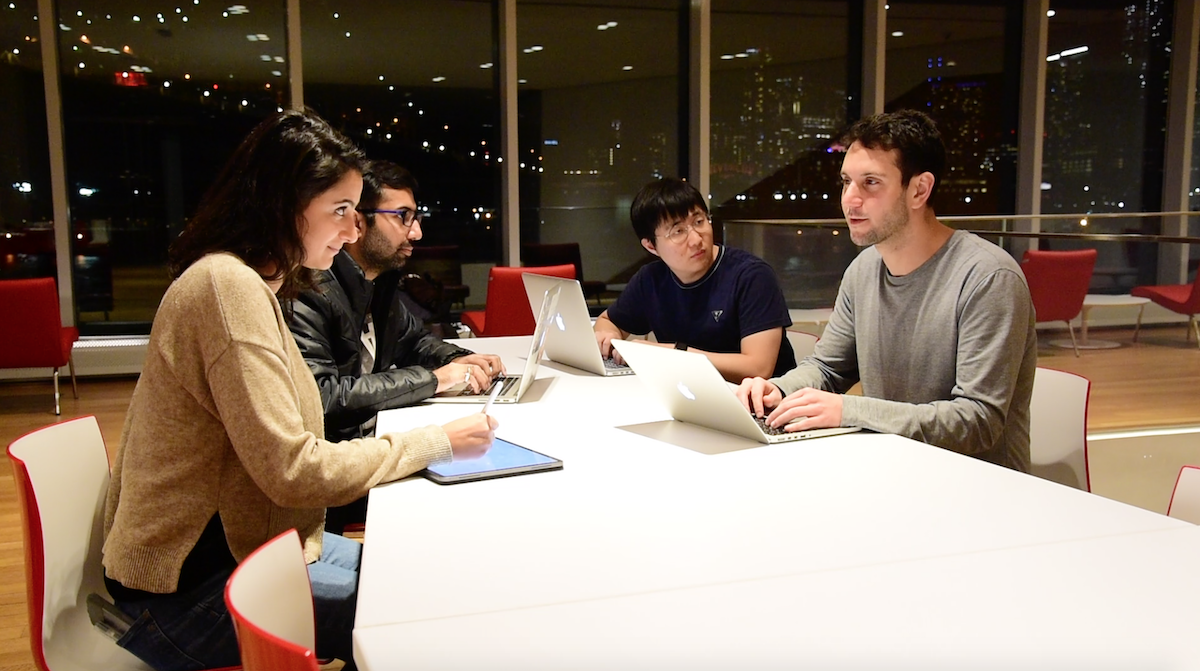
Solving shared problems collectively
Asper, Ladkani, and their fellow co-founders, CEO Yasmin Lalani, Johnson Cornell Tech MBA ‘20, and Chief Design Officer Ryan Kim, Master of Engineering in Computer Science ‘20, each encountered their own difficulties as they left home as adults. Daniel, Sunny, and Yasmin all graduated the MBA program and met last summer in Ithaca, while Ryan joined the crew in NYC after he and Daniel immediately clicked in an AR/VR class. “We all complement each other very well — we are each confident in our different ideas, qualities, and skills,” said Ladkani.
“Our idea affects me personally — I’m Korean, so my family lives overseas,” said Kim. “We always had a problem keeping track of documents and other things, so when Daniel came to me, the idea jived with me. So, I bring my personal skills and passion into this.”
“Similar to Ryan, I have a spread-out family,” said Lalani. “My dad once gave me an elaborate printout — kind of a treasure hunt — which clued us to his bank account password. Then in a bathroom cabinet, there’s a key to a safety deposit box in New Jersey. As much as I’d like to think I’m the type of person to remember all that amid panic and confusion, it’s stressful to think that if something happened I wouldn’t be able to find all the important stuff.”
These stressors led the team to seek confirmation that the difficulties were widespread. After confirming these same problems in their peer group, they started conducting user interviews for those who would use the product. “We wanted to both build a product and create something meaningful and powerful to solve these problems,” said Asper. “We first worked with our own families to develop the concept and product. It allowed us to go deep into what the product needs to look like.” Like Asper’s day at the museum, OnePlace will showcase the uniting importance of small groups on a practical and emotional level. “We liked the idea and felt that even in the worst-case scenario, we’d build it for our four families. So I was on board with that,” said Lalani.
The slow roll-out toward a long-term solution
The intended business model will be priced as either a monthly or annual fee that will be lower than the price of a streaming service to store the information on the platform. The OnePlace team said they would welcome corporate partnerships, but will not sell user data to third parties, and only anticipate using data from the platform to make it more functional and beneficial for users.
They are avoiding a traditional marketing campaign, opting instead for a focus on building out the product and paying close attention to the concerns of beta users. The team wants the product to be refined before scaling out too quickly. “We are always wanting to listen to customers and won’t stop doing that,” said Asper. “We don’t want to lose touch with them. Adaptations will have to be made, so we are building it to be flexible, thoughtful of how it can change, and building it so that a person in your family in 100 years will benefit from it.”
OnePlace seeks to bring the type of reconvergence of the important information families rely on both now and into the future, toward the yet-to-be-born generation who will reap the benefits of what is placed in the digital rucksack of OnePlace.

Legal writing has a reputation, and not for easy reading. A century ago, writer Franz Kafka imagined “the Law” as part nightmare, part cultural unconscious: irrational, enigmatic, and stubbornly invulnerable to critique. Anyone who watches the Sunday news shows or listens to AM talk radio knows that something has changed. Constitutional law in the United States today is hotly debated—a juridical wrestling match complete with opposing, media-branded schools of interpretation. Meanwhile, the budget of the United States Supreme Court alone exceeds $84 million annually. As a nation, we invest a lot of money and expertise to clear up legal ambiguities and to decide how laws—written months, decades, or centuries ago—should be applied to present-day situations.
Can we avoid all that? According to James Grimmelmann, Law, computer programmers and legal thinkers have occasionally shared a common dream: What if laws employed the hard-and-fast logic of C++? Imagine courts that run with the accuracy and efficiency of a supercomputer. One circuit court judge, commenting on the Supreme Court’s 2020 Bostock decision, voiced his ideal of jurisprudence like this: “A computer programmer may write faulty code, but the code will perform precisely as written regardless of what the programmer anticipated. Courts, no less than computers, are bound by what was typed, and also what was mistyped.”
“That’s a reasonably common view about legal language and programming that you find among some people in law,” Grimmelmann says. “There’s this idea of a computer that is rigid and literal—and perhaps the law could be more like that.”
Categories